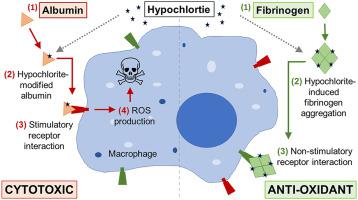Redox Biology ( IF 10.7 ) Pub Date : 2020-12-30 , DOI: 10.1016/j.redox.2020.101847 Noralyn Mañucat-Tan 1 , Rafaa Zeineddine Abdallah 2 , Harsimran Kaur 1 , Daniel Saviane 1 , Mark R Wilson 2 , Amy R Wyatt 1

|
Fibrinogen, a major constituent of blood plasma, is highly susceptible to reaction with biological oxidants. It has been proposed that fibrinogen plays a role in antioxidant defence, but oxidation of fibrinogen is also known to disrupt normal blood clotting and is implicated in the pathology of atherosclerosis. In the present study, we show that the biological oxidant hypochlorite promotes the formation of soluble high molecular weight fibrinogen assemblies ≥40 × 106 Da, that do not accumulate when fibrinogen is induced to aggregate by other stresses such as heating or hydroxyl-mediated damage in vitro. Hypochlorite-modified fibrinogen is stable at 37 °C as assessed by precipitation assays, and has reduced susceptibility to iron-induced (hydroxyl-mediated) precipitation compared to native fibrinogen. In contrast to hypochlorite-modified albumin, which is known to be immunostimulatory, hypochlorite-modified fibrinogen does not induce RAW 264.7 (macrophage-like) cells or EOC 13.31 (microglia-like) cells to produce reactive oxygen species or induce cell death. Furthermore, depletion of fibrinogen from human blood plasma increases the immunostimulatory property of blood plasma after it is supplemented with hypochlorite in situ. We propose that reaction of hypochlorite with fibrinogen in blood plasma potentially reduces the accumulation of other hypochlorite-modified species such as immunostimulatory hypochlorite-modified albumin. The latter represent a novel role for fibrinogen in blood plasma antioxidant defence.
中文翻译:

次氯酸盐诱导的纤维蛋白原聚集是血浆中新型抗氧化剂的基础
纤维蛋白原是血浆的主要成分,极易与生物氧化剂发生反应。已经提出纤维蛋白原在抗氧化剂防御中起作用,但是还已知纤维蛋白原的氧化破坏正常的血液凝结并且与动脉粥样硬化的病理学有关。在本研究中,我们表明生物氧化剂次氯酸盐促进≥40×10 6 Da的可溶性高分子量纤维蛋白原组件的形成,当纤维蛋白原被其他应力(例如加热或羟基介导的损伤)诱导聚集时不会聚集体外。次氯酸盐改性的纤维蛋白原通过沉淀分析评估在37°C下稳定,并且与天然纤维蛋白原相比,对铁诱导的(羟基介导的)沉淀的敏感性降低。与已知具有免疫刺激作用的次氯酸盐修饰的白蛋白相反,次氯酸盐修饰的纤维蛋白原不会诱导RAW 264.7(巨噬细胞样)细胞或EOC 13.31(小胶质样)细胞产生活性氧或诱导细胞死亡。此外,从人体血浆中去除纤维蛋白原后,原位补充次氯酸盐可增强血浆的免疫刺激特性。。我们建议次氯酸盐与血浆中的纤维蛋白原反应可能会减少其他次氯酸盐修饰的物质(如免疫刺激性次氯酸盐修饰的白蛋白)的积累。后者代表纤维蛋白原在血浆抗氧化剂防御中的新作用。











































 京公网安备 11010802027423号
京公网安备 11010802027423号